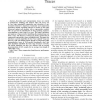Free Online Productivity Tools
i2Speak
i2Symbol
i2OCR
iTex2Img
iWeb2Print
iWeb2Shot
i2Type
iPdf2Split
iPdf2Merge
i2Bopomofo
i2Arabic
i2Style
i2Image
i2PDF
iLatex2Rtf
Sci2ools
123
click to vote
MASCOTS
2010
2010
Efficient Discovery of Loop Nests in Execution Traces
Execution and communication traces are central to performance modeling and analysis. Since the traces can be very long, meaningful compression and extraction of representative behavior is important. Commonly used compression procedures identify repeating patterns in sections of the input string and replace each instance with a representative symbol. This can prevent the identification of long repeating sequences corresponding to outer loops in a trace. This paper introduces and analyzes a framework for identifying the maximal loop nest from a trace. The discovery of loop nests makes construction of compressed representative traces straightforward. The paper also introduces a greedy algorithm for fast "near optimal" loop nest discovery with well defined bounds. Results of compressing MPI communication traces of NAS parallel benchmarks show that both algorithms identified the basic loop structures correctly. The greedy algorithm was also very efficient with an average processin...
Related Content
| Added | 29 Oct 2010 |
| Updated | 29 Oct 2010 |
| Type | Conference |
| Year | 2010 |
| Where | MASCOTS |
| Authors | Qiang Xu, Jaspal Subhlok, Nathaniel Hammen |
Comments (0)

